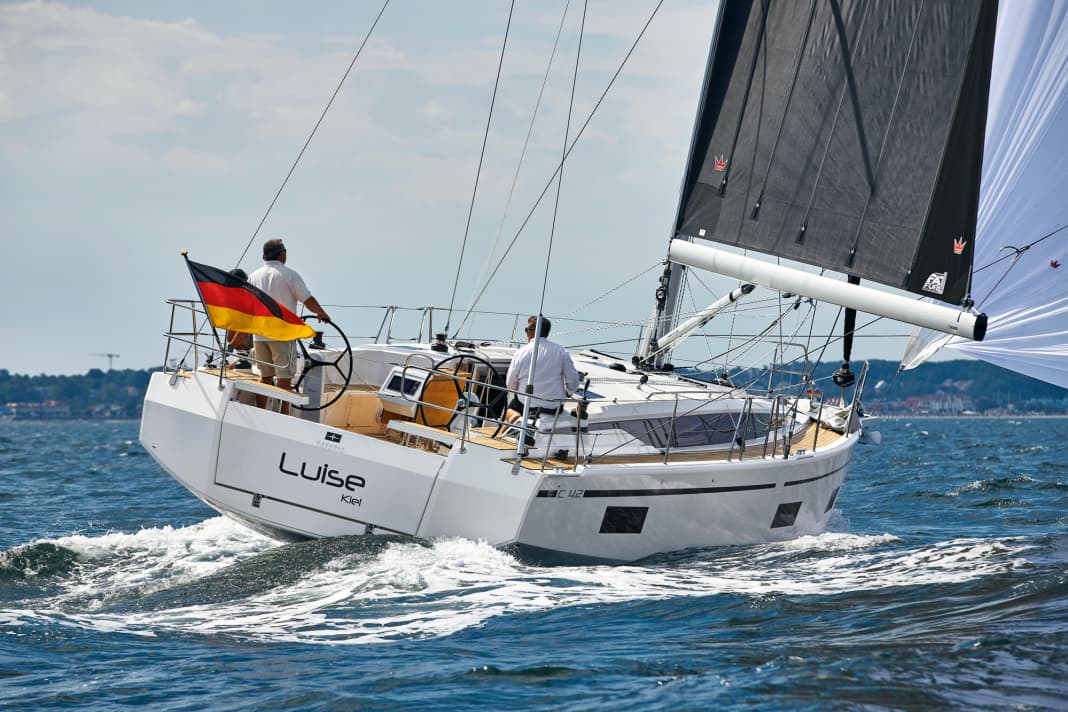





Length runs? Yes - but width too. Dimensionally stable yachts, which derive a large part of their righting moment from their overhanging frame, have been commonplace in the regatta scene for decades, as long as the current regatta formula favours this design feature. However, the trend initially remained with wide sterns, which also promote planing, while the bow sections remained sharp. Then, a few years ago, voluminous foreships were added, right up to the scow hull. The boats with a voluminous or even flat nose at the front won the Transat Minis or the Class 40.
The Imocas were also constructed according to this design principle. The hull shape, which is buoyant in the bow area, provides more stability and ensures consistent waterlines at different heeling angles because the boat does not trim when the boat is in position. Constructions with wide sterns usually tend to do this, which then tip onto the nose, lever out the stern and therefore also require double rudder blades.
Despite its great width, the Bavaria C42 manages with one rudder blade
Designer Maurizio Cossutti and his counterpart at Bavaria, Product Manager Pascal Kuhn, utilised these principles and findings when developing the C42. With a width of 4.29 metres, which extends from the centre of the boat to the transom, and the voluminous foredeck with the wide stem at the top, the yacht does not tilt onto the bow as the angle of heel increases, but instead rotates more or less only around its longitudinal axis. Despite the width, there is only one deep central rudder blade, which saves weight, money and adjustment. Sharp chine edges, which run out slowly to the foredeck, are intended to provide even more stability.
These are all sailing advantages - but they also help with cruising comfort, the actual aim of the measures. The large beam, chines and V-bow create a huge volume below deck. Two generous berths can be accommodated in spacious cabins in the stern, and the berth in the foredeck can be moved further forwards. Product Manager Pascal Kuhn: "We have optimised the usable living length of the C42."
The Bavaria C42 is powerful and dynamic
With its V-bow, chines and large width, the new Bavaria C42 has its own face, but with its striking, finely tapered superstructure line it is still reminiscent of the C-Line family with the C45, 50 and 57 models, which is being expanded in parallel with the conventional cruiser series. Designer Cossutti and the Bavaria team have managed to make the wide C42 look not only modern but also powerfully dynamic through the skilful use of angles and edges. The large area of the wide transom, for example, is not vertical throughout, but angled, giving it a less opulent appearance. All in all, a design and construction that is aimed at both sailing efficiency and comfort through space.
In the 2020 YACHT test, the Bavaria C42 is positioned with the stern towards the flat bridge to make it easier to walk on. The stern platform is smaller than possible; the GRP part has already been designed to fit the C38 as part of the cost-effective equalisation of parts Another striking feature: the pushpit is offset aft to gain some more space in the cockpit.
The bow thruster helps when casting off, but it was installed in a tunnel rather than being retractable, which is the more reliable and solid solution, but costs a little speed; however, this was hardly noticeable under sail. The new owner, who had previously owned a Bavaria 36 for many years, had dipped into his wallet and ordered a high-tech sail set that doesn't even appear on the options list: Epex membranes from Elvstrøm with Technora Black load lines and the whole thing protected with black taffeta, to be set on a furling rig, an extra that only costs a little space with a vertically battened sail. Even with the smaller standard self-tacking jib, the sail load factor is comparatively high at 4.5. The value improves to a full 4.7 when the optional genoa is ordered.
The Bavaria C42 is a pleasure to steer
In 13 to 16 knots of wind, the Bavaria C42 delivered a very solid performance, even with a furling rig: With pressure in the sails, she lays down on the chine and stays there with a heel of just under 20 degrees, a very healthy angle for the performance and pleasant to boot. Speeds vary between 6.8 and 7.2 knots depending on height and wind speed, and the usual tacking angles of 90 degrees are easily achieved.
The boat steers with a pleasantly appropriate rudder pressure. The Jefa system with a chain and wire transmission was perhaps a little tight, but this is a matter of a few turns with a spanner - and the mechanism is easily accessible under a flap in the cockpit. The rudder doesn't dive out even when the boat is in an upright position, the voluminous bow is not noticeable when sailing, everything is fine. Speed and height are easy to call up, the C42 is one of those boats that is easy and pleasant to steer, a characteristic that not all designs have. One full and two-thirds turns are required from stop to stop, which is just direct enough.
Sheet guides as required
The 90-centimetre wheels (Bavaria also uses outdated steel as standard here) are positioned quite far inwards in view of the wide cockpit, and the helmsman cannot lean against the railing when sitting sideways without a back cushion (which is available as an extra). And on the starboard side, the helmsman sits somewhat cramped due to the crank-operated backstay tensioner.
The travellerless mainsheet is double and attached to the coachroof. Two separate sheets lead from the deck along the boom, forwards onto the superstructure and to the only two winches in the series standard on the companionway, which are also used for the halyards. Anyone ordering a genoa or even a code zero and gennaker will invest in two additional drums on the coaming. And if you want to get involved in the sailing action from the wheel, even with a small crew or as a helmsman, you can have two winches on deck aft, with which the self-tacking jib or the genoa and mainsheet can be operated. The double mainsheet has advantages in any case: The boom can be pulled to windward even without a traveller, and in a strong-wind jibe the crew can sheet the boom with two sheets in a very controlled manner.
Plenty of storage space and room on deck
Other special features on deck: The three-cabin version also offers more than just the usual two storage spaces in the dents: A large part of the stern is also used for stowage, with a volume of around 600 litres, enough for an additional sail or a folded inflatable boat.
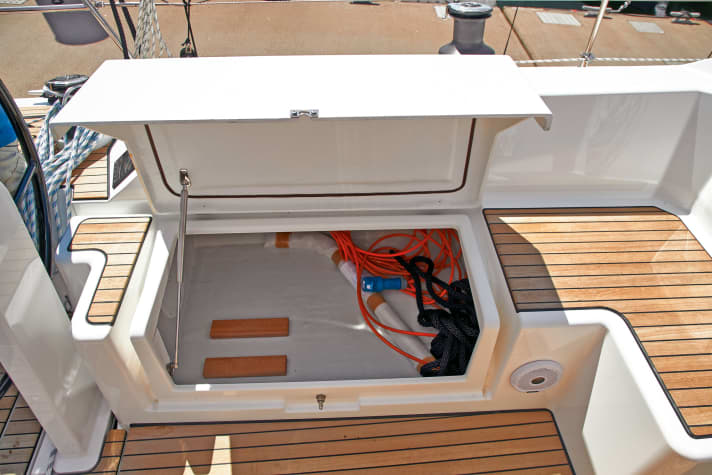
And the V-bow allows a small sail load, which would be better utilised with a larger cover, but is sufficient for fenders and lines in any case. Another advantage of this bow shape is the wider and therefore more accessible deck at the front. The optional bowsprit, which encloses the anchor, serves as an attachment point for the neck of the gennaker or code zero and can be fitted with a ladder, which makes the boat North Europeanised, also contributes to this: Then it is also possible to go ashore onto the flat jetty or skerry with the bow first. The only thing missing is the rubbing strake, also an extra.
Things like this show the shipyard's endeavours to keep costs low for a competitive price. Fixed cleats instead of retractable or retractable cleats or uncovered halyards on the coachroof also stand for this - both things that can be glossed over: Rigid cleats are less susceptible and more durable; halyard channels are difficult to keep clean, fittings mounted in them are complicated to reach and lines are more difficult to replace.
The Bavaria C42 offers many options below deck
And off through the double-door companionway via the five-step, easily accessible staircase into the interior. The test ship has a light wood veneer, oak was the choice, otherwise the shipyard supplies reddish-dark mahogany in combination with a light-coloured floor in elm look. Another alternative is a dark walnut finish.
Two cabins are standard, then there is a huge storage space on the port side, and the galley is extended aft by a large locker in which a second refrigerator, a freezer or additional storage space can be realised. The options are quite expensive: the second aft cabin costs 2963 euros, the oak interior 4272 euros and a wet room in the foredeck 4867 euros. And for 2487 euros, the saloon table can be lowered and covered with cushions. This creates another double berth there, albeit a narrow 1.35 metres. The saloon table can be folded out to 1.18 x 1.18 centimetres. It can then also be used by co-sailors sitting on the second sofa on the port side. However, the rods holding the table top seem too weak and the whole thing is quite wobbly.
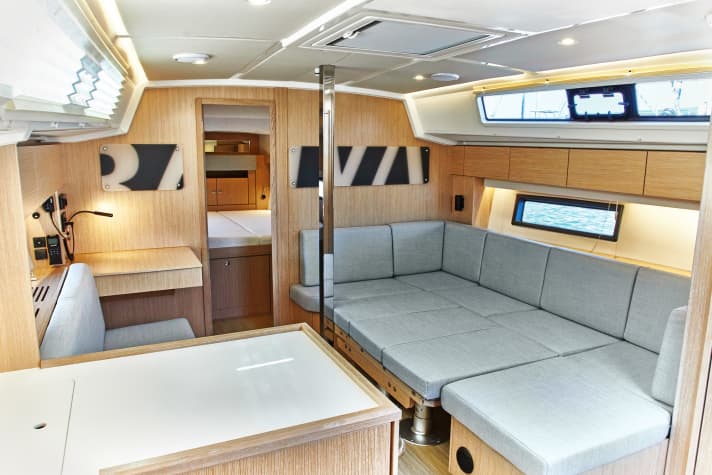
The standard is lacking here and there
Good marks overall for the galley: the work surface is large, as is the storage space, there are numerous storage options, even for small items, and the refrigerator has a standard household capacity of 110 litres. And the fairly deep and neatly designed bilge is also ideal for stowing food.
Two large worktops adjoin the cooker. However, there are shortcomings: the gimbal system of the oven hob, which is even equipped with the unusual three burners, already strikes at 17 degrees on the port bow, which is not enough. And in the standard version, the cross ventilation in the saloon and galley is not sufficient. The small hinged windows set into the superstructure panes are only available on board as an extra and cost 1654 euros. There are other things that the customer will miss in the basic version. For example, the battery capacity of 180 ampere hours is scarce.
There is also a navigation system on the main bulkhead with an area of 74 by 60 centimetres, which will mutate into a mini-office in view of today's technology and behaviour. Nevertheless welcome: Charts can be stored in a vertical compartment integrated into the table, reminiscent of the baguette compartment on some earlier boats from France.
Plenty of space in the rear
The standard bathroom in the saloon is equipped with a shower compartment, which also houses the toilet and is separated by a Plexiglas door. Good: The hull openings and sea valves come from the New Zealand company Trudesign; they are made of high-strength plastic, are temperature-resistant and, above all, more durable than the metal versions usually used.
And in the bow and stern, the advantages of the large hull volume are evident, which has already helped the boat to sail well: The aft berths are both 1.60 metres wide and rectangular, while the cabins are airy and spacious. There is even enough space between the berths for a wide sound-insulating channel to accommodate hoses and installations, and behind the berths for a technical room and the aforementioned deep locker. The owner's cabin in the foredeck even accommodates a 1.80 metre wide berth at shoulder height and plenty of storage space in cupboards and under the mattress.
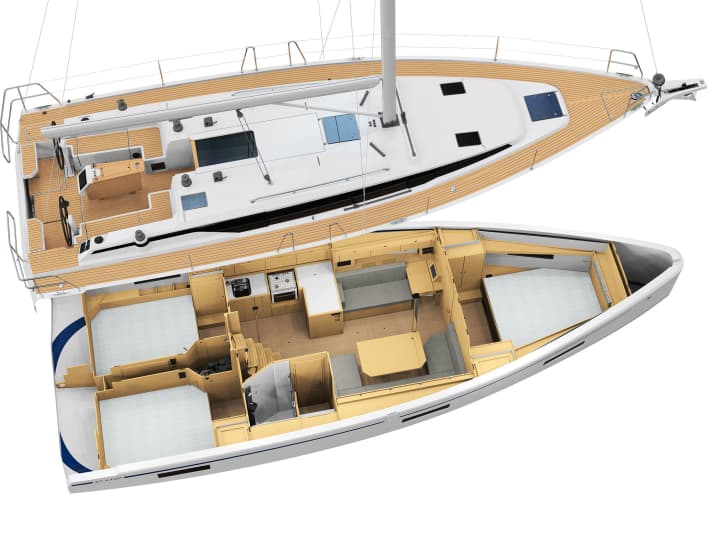
Back to the old strength
The Bavaria C42 is a pleasure to sail and steer, at least when fitted with good cloths. Keels, rigging, cloths, interior fittings: the C42 can be highly customised. The operation of the sheets is quickly adapted to personal requirements. The ergonomics are essentially perfect. And the progressive lines are likely to find their fans. All in all, a harmonious package that stands for Bavaria's future. And the price is right. Just under 260,000 euros for the twelve metre long boat as standard.
The honest boat at a fair price - the shipyard has achieved this return with flying colours and has also delivered a yacht with that certain something extra. The customer must be pleased, the selection in this popular class has become larger and even more attractive.
Measured values Bavaria C42
Sailing performance, without drift and current
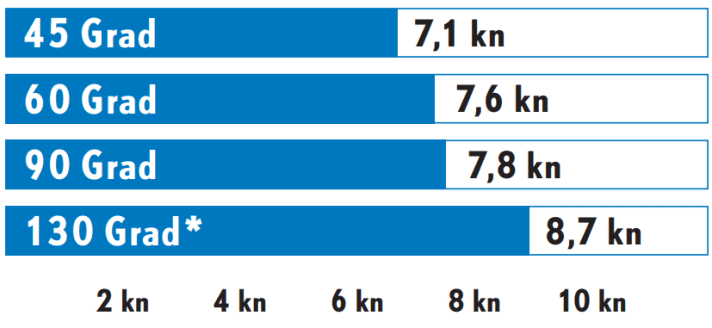
Wind speed: 12-15 kn (4 Bft.); wave height: swell approx. 0.4 metres
* With gennaker
Potential

The sail carrying capacity is calculated with the self-tacking jib (standard)
1 Dimensionless number. Calculation: 2√S/3√V. The higher the value, the more sail area (S) the ship has in relation to the displacement (V).
Bunk mass
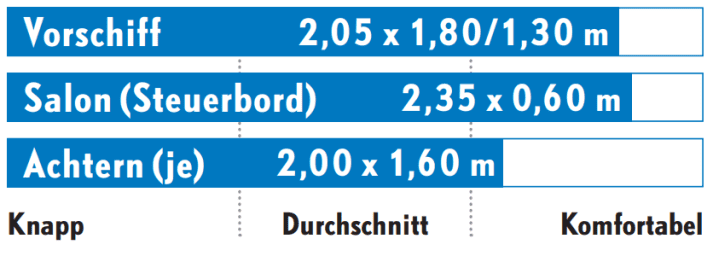
YACHT review Bavaria C42
Stiff, fast, variable deck layout, generous spaces, stylistically individual: the first of the new line can and does make an impression. The volume record does not entail any visual deficits. Rather sparsely equipped in the standard version, but still favourable in any case
Design and concept
- + Large torso volume, also at the front
- + Low base price
- + Solid and proven construction
Sailing performance and trim
- + Good sailing potential
- + sheet guides of your choice
- - Only optionally suitable for single-handed use
Living and finishing quality
- + Very clean finish
- + Very large bunks
Equipment and technology
- + Quality of the components
- + locker storage space for three cabins
- - Sail load cover is too small
- - Many parts only as an extra
Technical data Bavaria C42

- Design engineer: Cossutti Yacht Design
- CE design category:A
- Torso length:11,98 m
- Overall length (with bowsprit):12,90 m
- Waterline length:11,27 m
- Width:4,29 m
- Draught/alternative:2,10/1,70 m
- Theoretical torso speed: 8.2 kn
- Weight: 9,7 t
- Ballast/proportion: 2,70 t/28 %
- Mast height above waterline: 20,10 m
- Mainsail: 53,8 m2
- Self-tacking jib:38,9 m2
- machine (Yanmar): 29 kW/40 hp
- Fuel tank (plastic): 210 l
- Fresh water tank (plastic): 210/460 l
- Holding tank (plastic): 70 l
Hull and deck construction
GRP sandwich using the hand lay-up method, foam core material. Full laminate below the waterline. Laminated bulkheads
Base price ex shipyard
259,777 euros gross incl. 19 % VAT (as at July 2023)
Shipyard
Bavaria Yachtbau, Bavariastraße 1, 97232 Giebelstadt; Tel. 09334/94 20; www.bavariayachts.com
This article first appeared in YACHT 16/2020 and has been revised for this online version.

